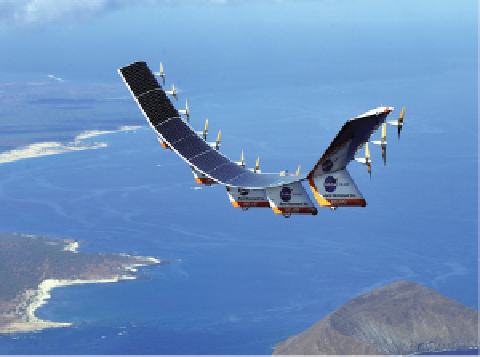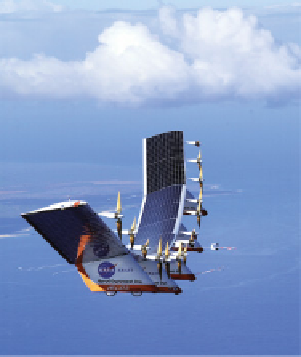Environmental Engineering Reference
In-Depth Information
2001, this plane set a world record for non-rocket-operated planes. Sadly, on 29
May 2003 it broke apart during a test fl ight and plunged into the Pacifi c Ocean near
Hawaii.
Figure 14.15
NASA's Helios aeroplane, powered only by solar cells, set a new world record for
altitude in 2001.
Photos: NASA, www.dfrc.nasa.gov.
14.4.4 Flying around the World in a Solar Plane
The Swiss psychiatrist, scientist and adventurer Bertrand Piccard is hoping to have
more luck with his solar aeroplane. He is mainly known for his trip around the world
in a hot-air balloon in 1999. His newest project is called Solar Impulse. What he
wants to do is circle the world in a glider that is powered only by solar energy. This
undertaking is designed to be an effective PR exercise in proving the technical pos-
sibilities offered by renewable energies. Unlike the NASA Helios aeroplane, this
will be a manned fl ight (Figure 14.16).
The planned start date is sometime in 2011. The fi rst prototype of the aeroplane has
already been built. It has a wingspan of around 61 m, weighs 1500 kg and is designed
to fl y at an average speed of 70 km/h. The main considerations in the construction
of the plane were the incorporation of optimal aerodynamic properties and extreme
lightness in weight. The wing surfaces are totally covered with solar cells. These
supply enough energy to power the aeroplane without the need for any additional
energy. During the day high-performance batteries store some of the solar energy
so that the plane can also fl y at night.
Whereas the prototype is only constructed for a 36-hour fl ight, a second aeroplane
is being developed with enhanced capabilities to enable several days of fl ying time
for fl ights around the world. This is necessary for crossing the Atlantic and bridging
other large distances. During the daytime the solar power propels the aeroplane to
heights up to 12 000 m. Powered by the solar energy stored in the batteries, the plane
will then be able to hold steady at an altitude of around 3000 m until the morning.


